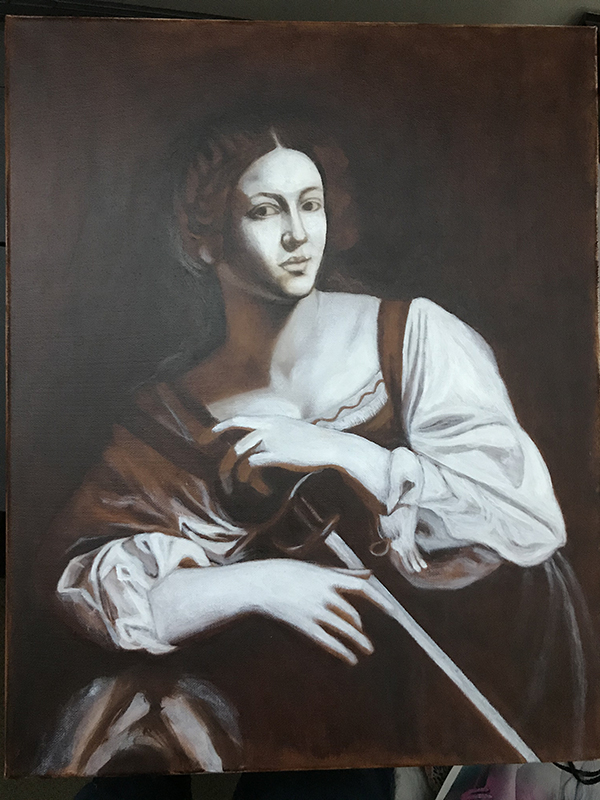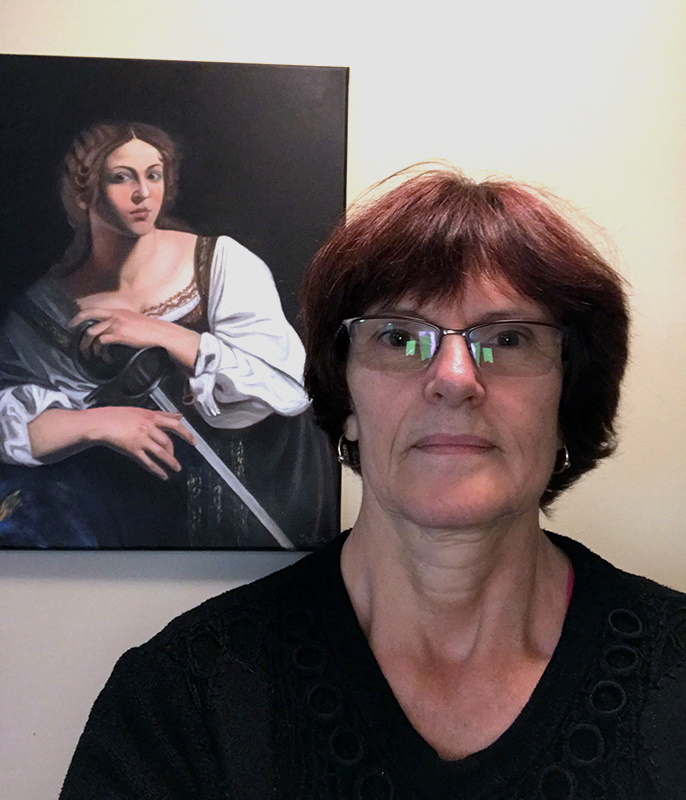Recently, I had the opportunity to take Martinho Correia’s workshop on Caravaggios’ late method of painting organized by the Kanata Art Club. It was a week-long online workshop on Zoom which ran from May 10th to the 14th daily from 9 am to 4 pm.
Martinho is a Canadian-born artist and art teacher, and he joined us on Zoom from his studio in Portugal, where he currently lives.
Prior to the workshop, about a week in advance, Martinho sent us instructions on how to prepare the canvas by glazing it with a thin layer of burnt umber. This is called campitura in Italian, preparing the field colour for the underpainting.
The workshop started by Martinho giving a short presentation on the life and works of Michelangelo Merisi da Caravaggio. I must admit that I am always awestruck whenever I look at Caravaggio’s body of work and I see his dramatic use of light and shadow known as chiaroscuro, which was adopted later by famous artists like Rembrandt and many others. My favourite Caravaggio painting is The Calling of St. Mathew, where the lighting is just magical. St. Catherine of Alexandria (shown below) is one of my favourite works as well. From the images supplied by Martinho prior to the workshop, we all chose to do a painting based on a detail of this masterpiece.

St. Catherine by Caravaggio
As a first step, we started by transferring the figure outline from our paper print to the canvas. Martinho suggested that we use a soft black carbon stick to blacken the back of the paper and then trace over the figure with a pencil over the paper on the canvas. This was just a quick means to get the proportions right and not waste time with drawing the figure by hand. I actually used graphite paper to transfer the figure outline and it worked fine for me. Here below is what that looked like.
 The next step was to darken the darkest spots on the painting with burnt umber mixed with a little ivory black. Following that, Martinho asked us to paint in white the lightest regions on the painting, which were the face, chest/neck, hands, and the sleeve and creases of the shirt. This technique, Martinho explained, was called abozzo. It was used to model the figure into some shape, using thicker paint on the lighter parts and thinner paint on the shaded ones. Here below is my painting in that stage.
The next step was to darken the darkest spots on the painting with burnt umber mixed with a little ivory black. Following that, Martinho asked us to paint in white the lightest regions on the painting, which were the face, chest/neck, hands, and the sleeve and creases of the shirt. This technique, Martinho explained, was called abozzo. It was used to model the figure into some shape, using thicker paint on the lighter parts and thinner paint on the shaded ones. Here below is my painting in that stage.
 Before starting with the colours on the canvas, Martinho demonstrated how to mix flesh colour paint by using a mix of yellow ochre, cadmium red, titanium white, burnt umber and burnt sienna. Following that, we did a head study of Catherine on a smaller canvas to try out the different flesh tones of the face. Here below is my study.
Before starting with the colours on the canvas, Martinho demonstrated how to mix flesh colour paint by using a mix of yellow ochre, cadmium red, titanium white, burnt umber and burnt sienna. Following that, we did a head study of Catherine on a smaller canvas to try out the different flesh tones of the face. Here below is my study.
 Next Martinho demonstrated how to mix the colours and paint the upper hand. And this is my rendering of that hand.
Next Martinho demonstrated how to mix the colours and paint the upper hand. And this is my rendering of that hand.
 The next step was to start painting the colours on the actual canvas. At the end of the workshop, my painting looked like this. I had a long way yet to make it realistic.
The next step was to start painting the colours on the actual canvas. At the end of the workshop, my painting looked like this. I had a long way yet to make it realistic.
And here is the finished painting, after about 2 weeks worth of work. Although I initially left room for the halo above her head, I decided not to paint it. I also omitted a part of the wheel, which would have made no sense in this detail.
 Conclusion: This has been my first time painting such a complex portrait in oil and using these techniques. But I am always up to new challenges, so this was a perfect opportunity for me to learn, connect with other artists, and push myself to see where I can go. I am a perfectionist, so the painting is still far from perfect, but I am OK with it. I am also having difficulty taking a good picture of the painting, so this above is the best one so far.
Conclusion: This has been my first time painting such a complex portrait in oil and using these techniques. But I am always up to new challenges, so this was a perfect opportunity for me to learn, connect with other artists, and push myself to see where I can go. I am a perfectionist, so the painting is still far from perfect, but I am OK with it. I am also having difficulty taking a good picture of the painting, so this above is the best one so far.
In addition to learning a new technique of portrait underpainting, which is almost similar to the grisaille method, what I mostly took away from this workshop was how to mix realistic Caucasian flesh colour, something I always struggled with.
I very much enjoyed the workshop, Martinho is an excellent teacher with years of teaching experience and a great portrait artist, in my opinion.

Me and Catherine 🙂
